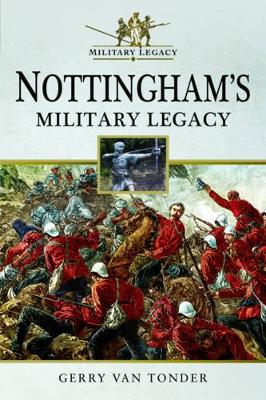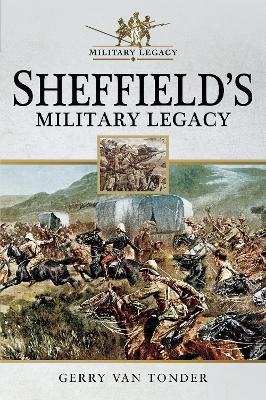Military Legacy
2 total works
Two years after landing on English soil in 1066, William of Normandy erected a strategic castle at Nottingham, thereby creating an enduring military nexus through to the modern era. On 22 August 1642, in his endeavours to quash Parliamentarian insurrection in the Midlands, King Charles raised his standard over Nottingham Castle, a rallying call to all Royalists to support their monarch. Loyalty to the Crown was, however, divided, and before long Parliamentarian forces garrisoned the castle. Late in the eighteenth century, a town troop of Yeomanry was raised in Nottingham, the foundation of the future South Notts Yeomanry. The yeomanry assisted regular troops by helping restore peace during the so-called Bread Riots of 1795, at a time when many of the town s men had been committed to military duty during the French Revolutionary Wars. Five troops of the town s yeomanry were again called up for service during the civil unrest of the Luddite Riots of 1811 18. This pattern of service continued over several decades. Evolving into a regiment, the yeomanry were repeatedly deployed against civil dissenters the Nottingham Riot, and the Reform Bill and Chartist Riots.After seeing combat during the Peninsula Wars in 1815, in the latter half of the 1800s, the 59th (2nd Nottinghamshire) Regiment of Foot formed part of a British invasion force into Afghanistan from India, to curb Russian interventionism in this remote and desolate region.
The outbreak of war in distant South Africa in 1899 placed enormous strain on Britain s military capability. From Nottingham and other county towns, regiments of yeomanry, Hussars and Sherwood Rangers were dispatched to the hostile environment of the African veld. Nottingham s sons then answered a call to arms in their thousands, only to also perish in their thousands on the Godforsaken soils of France and Flanders during the holocaust that was the Great War. Through the Second World War to the present, Nottingham s military units underwent successive phases of metamorphosis from infantry to anti-aircraft and searchlight formations, followed by the relatively recent absorption into a regional entity: the Mercian Regiment. Today, Nottingham s castle and surrounds bear the symbols of a rich and diverse military legacy symbols of remembrance, of tribute, and of a tableau of military pride from ancient times.
The outbreak of war in distant South Africa in 1899 placed enormous strain on Britain s military capability. From Nottingham and other county towns, regiments of yeomanry, Hussars and Sherwood Rangers were dispatched to the hostile environment of the African veld. Nottingham s sons then answered a call to arms in their thousands, only to also perish in their thousands on the Godforsaken soils of France and Flanders during the holocaust that was the Great War. Through the Second World War to the present, Nottingham s military units underwent successive phases of metamorphosis from infantry to anti-aircraft and searchlight formations, followed by the relatively recent absorption into a regional entity: the Mercian Regiment. Today, Nottingham s castle and surrounds bear the symbols of a rich and diverse military legacy symbols of remembrance, of tribute, and of a tableau of military pride from ancient times.
In the century following the Norman invasion, a castle was built at the confluence of the rivers Sheaf and Don, an early recognition of Sheffield s strategic importance. Destroyed in the thirteenth century during the Second Barons War, a second castle was built on the site, but in 1647, it was ordered to be demolished immediately after the cessation of the Civil War, thereby negating any future tactical use by either Parliamentarian or Royalist. Steel production and downstream manufacturing would, however, be perpetually embedded in the military legacy of this seat of industrial innovation and production. The Vickers steel foundry was established in Sheffield in 1828\. Following the manufacture of the factory s first artillery in 1890, Sheffield expanded to find itself a leading supplier in the First World War, feeding the military with shells, artillery, naval guns, armour plating, aircraft parts, torpedoes, helmets and bayonets. Sheffield s contribution to the British war machine in the Second World War quickly attracted the attention of Nazi Germany.
In December 1940, in an operation appropriately codenamed Schmelztiegel, or Crucible, Sheffield suffered two major raids aimed primarily at steel and munitions factories. A proud tradition of answering a call to the colours spawned the 84th Regiment of Foot, the Loyal Independent Sheffield Volunteers of the 1700s, the Hallamshire Rifle Volunteers raised in 1859, and the Sheffield Squadron, Yeomanry Cavalry. The 1899 1902 Anglo-Boer War would also have an enduring legacy: the Sheffield Wednesday football stadium was named Spioen Kop, while local road names include Ladysmith Avenue and Mafeking Place. On 1 July 1916, the Sheffield City Battalion fought in an heroic and costly, but hopeless, action on the Somme to capture the village of Serre. Through the Second World War right up to Afghanistan, Sheffield s men and women in uniform have not been found wanting.
Sheffield s rich military legacy portrayed in this publication is drawn from a cross section of representative units, home and foreign actions, uniformed personalities, barracks at the hub of musters, the calibre of gallantry including six Victoria Crosses as well as the immortality of names on memorials, such as the Sheffield Memorial Park in France.
In December 1940, in an operation appropriately codenamed Schmelztiegel, or Crucible, Sheffield suffered two major raids aimed primarily at steel and munitions factories. A proud tradition of answering a call to the colours spawned the 84th Regiment of Foot, the Loyal Independent Sheffield Volunteers of the 1700s, the Hallamshire Rifle Volunteers raised in 1859, and the Sheffield Squadron, Yeomanry Cavalry. The 1899 1902 Anglo-Boer War would also have an enduring legacy: the Sheffield Wednesday football stadium was named Spioen Kop, while local road names include Ladysmith Avenue and Mafeking Place. On 1 July 1916, the Sheffield City Battalion fought in an heroic and costly, but hopeless, action on the Somme to capture the village of Serre. Through the Second World War right up to Afghanistan, Sheffield s men and women in uniform have not been found wanting.
Sheffield s rich military legacy portrayed in this publication is drawn from a cross section of representative units, home and foreign actions, uniformed personalities, barracks at the hub of musters, the calibre of gallantry including six Victoria Crosses as well as the immortality of names on memorials, such as the Sheffield Memorial Park in France.

